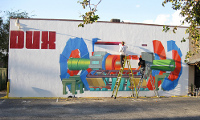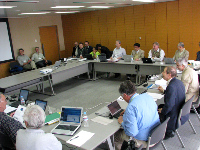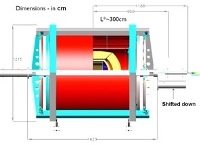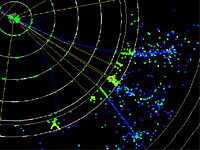Writing the LOI is like “creating a painting”
LOI editors are proud of their work – and glad it's over

A bit like writing an LOI: a mural of the ATLAS detector in South Carolina. Photo on flickr by Kristofoletti. |
Some 400 pages of calculations, simulations, detector descriptions, estimates, some 1000 signatories from all round the world, hours spent on the phone or clustered around conference tables – a lot of hard work and careful thinking went into the Letters of Intent (LOI). Each of the three submitted letters – for ILD, for SiD and for the 4th concept or 4th for short – managed to meet the deadline, and even though they didn't manage to stick to the recommended page limit of 100, they were all accepted and are being scrutinised by the international detector advisory group IDAG (see this week’s other feature). This is a story about how an LOI is written, as told by the authors and editors.
Read more...
-- Barbara Warmbein |
 |
|
|
 |
Upcoming meetings, conferences, workshops
11th European Symposium on Semiconductor Detectors
Wildbad Kreuth Conference Center, Bavaria, Germany
7-11 June 2009
Tesla Technology Collaboration Meeting (TTC09)
LAL, Orsay, France
16-19 June 2009
ILC-CLIC LET Beam Dynamics Workshop at CERN
CERN, Switzerland
23-25 June 2009
Polarized Positron for Linear Colliders Workshop (Posipol 2009)
IPNL, Lyon, France
23-26 June 2009
FCAL meeting
DESY Zeuthen, Germany
29-30 June
Upcoming schools
The 2009 Hadron Collider Physics Summer School
CERN
8-17 June 2009
Summer School on Particle Physics, Cosmology and Strings
Perimeter Institute, Waterloo, Canada
24 June - 1 July 2009
International School of Physics "Enrico Fermi" (SIF)
Radiation and particle detectors
Varenna, Villa Monastero, Italy
20-25 July
|
|
|
GDE Meetings calendar
View complete ILC calendar
|
|
|
 |
Evaluating the ILC detector concepts
“A noteworthy step in the genesis of ILC detectors,” said Michel Davier, chair of IDAG.

IDAG receiving all detector concepts for a benchmarking session. |
Since the end of March, when the detector concept groups delivered their Letters of Intent, the International Detector Advisory Group (IDAG) has been experiencing an intense period. At TILC09 in Japan, the panel worked and interviewed the detector concept groups for three days. All sessions were closed to other participants, but ILC NewsLine wanted to know more about what happened there and understand details about the whole process of detector evaluation.
Read more...
-- Perrine Royole-Degieux |
 |
|
|
 |
From KEK
12 May 2009
[URGENT MESSAGE] - Preventive measure against the Influenza A(H1N1) (Swine Flu) epidemic
Read more... |
|
From New Scientist
12 May 2009
Finding antimatter in the real world
Theories of physics say that the universe exploded into existence some 13.7 billion years ago with the big bang. At that instant, matter and antimatter existed in equal amounts because the laws of nature require that matter and antimatter be created in pairs.
Read more... |
|
From Scinexx
12 May 2009
Elektronen surfen auf der Plasmawelle
Forscher entwickeln Konzept für Teilchenbeschleuniger der übernächsten Generation
Read more... |
|
From CERN
11 May 2009
Austrian participation in CERN
This afternoon, a meeting took place in the Ministry of Science and Research in Vienna between Austrian Science Minister Johannes Hahn, CERN1 Director-General Rolf Heuer, and CERN External Relations Coordinator Felicitas Pauss. In a constructive working meeting, Minister Hahn explained the reasons for wishing to end Austrian membership of CERN at the end of 2010.
Read more... |
|
From KEK
11 May 2009
Using Crab Cavities, KEKB Breaks Luminosity World Record
A team of accelerator physicists at the KEK High Energy Physics Laboratory in Tsukuba, Japan, has broken the world's luminosity record by utilizing new accelerator devices called "crab cavities."
Read more... |
|
|
 |
 |
|
|
 |
Progress on ILC machine-detector interfaces through the detector LOI process

A view of the 4th Detector Concept featuring dual solenoids and end wall current coils |
The TILC09 workshop in Japan from17 to 21 April was particularly notable as it featured the first presentations of the ILC detector Letters of Intent (LOI). Although this process precedes the solicitation of ILC detector proposals or formation of ILC collaborations, it is a very important step in understanding and defining the enabling R&D, understanding interfaces with the machine and assessing the capabilities of ILC detectors. Three LOIs were submitted at the end of March and IDAG, the International Detector Advisory Group reporting to the ILC Research Director, Sakue Yamada, has now begun to assess them towards a validation for the next step, a technical design. This process will be very valuable in guiding the development of a realistic plan and scope for the experimental programme on the same time scale as the accelerator technical design report (TDR) we are preparing, meaning a technical design by the end of 2012.
Read more...
-- Barry Barish
Director's Corner Archive |
 |
|
|
 |
The detector archive

If you want to learn more about concept detectors and retrace the past steps in detector design and R&D, we have made a selection of relevant articles published in ILC NewsLine over the years.
To the archive
|
|

